
Focal Reduction Information
This section will speak in more detail to the evolution of the Everstar Equiptment set up. I will share the pain I have had with you so that your own set up becomes easier. I will be sharing the shameful images produced from the setup and show how they will hopefully evolve to nice ones.
12/10/00
I realized that it has been too long since I visited this subject. I have given a few presentations on the subject and am far from having any real mastery of the subject. Today EverStaR still uses a Meade Focal Reducer. With the CFW8 permanentylu mounted to the camera the configurations runs at F4.21 and provides an approximate 15 x 24 FOV.
This results in a non uniform vignetting pattern that can often lead to some frustration when sky conditions are less than ideal. This has a tendency to create a gradient effect across the image when attempting tri color images where the images is reddish in the top right corner and works its ay to greenish in the bottom left corner.
Flats seem to help this as well as adding a luminance layer. Ultimately I will be replacing this camera, filter wheel and Focal reducer configuration for new equipment which features a larger chip, a 2" filter wheel and possibly no reduction which should help eliminate vignetting al together.
One interesting consideration about reduction though is that the lower the F ration the more sensitive your configuration is, thus equating to shorter exposure times to achieve the same magnitude. This means a 10" scope can hit any given magnitude faster at F 4 verses F10. If this makes you confused, your not alone, there is a lot to consider on the subject. The primary reason I still run at F 4.21 today lies with this last point as just recently I was able to reach 20th mag and beyond in a 700 second guided shot with 19.5 mag stars appearing clearly when referencing the image to the USNO catalog. This was the difference in being able to recover an asteroid from Kitt Peak verses leaving it lost in space.
Some of the information below should help you understand the subject better. On this update I will leave you an ugly 60 second flat from last night. Imagine this beast lurking behind your pretty pictures and you will see why you personally may come to a different conclusion about what is right for you.
| ||
| ||
| ||
| ||
| ||
|
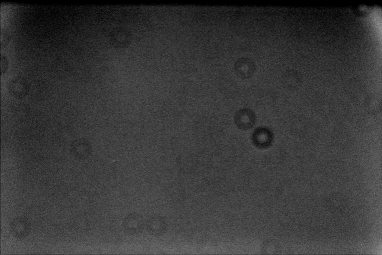
11/13/99
We have ditched the JMI Motofocuser and have installed a knob based motofocus (also ny JMI)
This has freed us from the problems of vignetting, however the knob based focusers are not as precise as the Motofocuser. Despite this, we are able to obtain focus now quicker than we ever have before. As you can read in the news section we are quite pleased.
Vignetting is barely noticeable at this point and our present configuration sits at F4 which represents a 15 X 23 field of view. This field of view allows us to cover more space while searching for Asteroids and has been very rewarding over the last few evenings.
I took two evenings and completely burned them on vignetting, Motofocusers, and field of view adjustments. I want to share some of the interesting things I discovered.
At one point I got very desperate when I compared the output from a 12" scope and ST7e camera with what was coming out of Everstar. Bright stars were missing in mine that stood out clearly in the 12" output. Even though this turned out to be due to having left the red filter on by accident, it (Doh!) motivated me work things out.
I purchased a 6.3 Meade focal reducer and tried it. The field of view was to small for my taste so I tried some other experimental configurations. The most interesting was ordered as follows:
Scope, 6.3 FR, JMI Autofocuser, 3.3 FR, CFW8/ST7e. This yielded a perfect non vignetted 100 x 130 field of view (yes in minutes). Of course the detail that is lost is not worth the effort to keep this configuration. But the thought of trying something in color is tempting.
All said and done and looking at the math:
you see that had I bought a F6.3 to begin with I might have been better off. The flip side of this is that it doesn't really consider the CFW8 in these tables. The F10 setup that I have reduces the F5 setup I have to F4. The impact on the F6.3 with 6.3 FL is not known here.

One of the first shots from Everstar. This is at the full F10, no focal reduction. This gives you an idea of what that looks like.

Image from the second night with the focal reducer installed. This is with a Meade F3.3 using a standard 1 /4 " eyepiece adapter to hold the camera. This is a large field of view weighing in at about 18' x 28' arc minutes. The vignetting is fairly pronounced, no flat field was subtracted. This was a 30 second exposure. We were chasing asteroid 1361 in this snapshot.
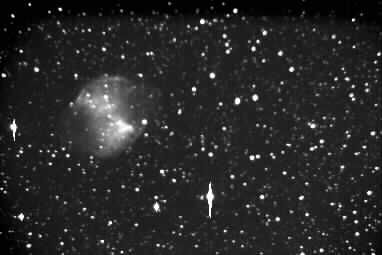
M27 60 seconds. This shows some of the woes of living off of a tripod. Long unguided exposures are not really possible. Same setup as above.
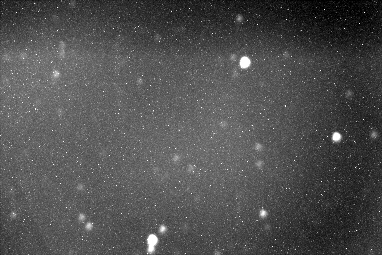
Chasing Asteroid 3308 in this one. Got guiding working. This is 6 minutes guided; however, I also played with the setup on this one and went to mounting the camera on to the motoficuser. At first I could not get the motofocuser to work with the focal reducer. This was because there was too much distance between the camera and the focal reducer. JMI sells a special adapter that allows the focal reducer and camera to be mounted behind the motofocuser. A flat field was also subtracted from this image. Larry taught me about flat fields. The flat field is taken before dark, but after sunset. The idea is to produce a vignetted image without stars. You can then subtract the flat field from your images to reduce the vignetting effect.

This is the flat divided into the image above. What we can see here--which I didn't know about until I spoke to Larry--was that I have a problem: the vignetting should be round. This is obviously not round. What I found was that I had a loose piece inside the motofocus that partially obstructed the view.
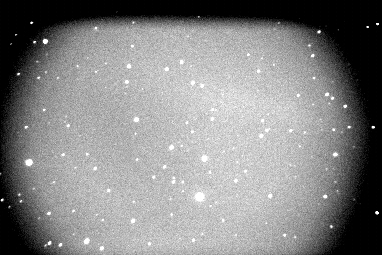
This image was taken after I removed the loose piece in the motofocus. The result was a rounder vignetting, but you can see that it is still off center. I still had more work to do. This theoretically is at F 3.3 with 30 second exposure. Vignetting can be a nasty thing to overcome.
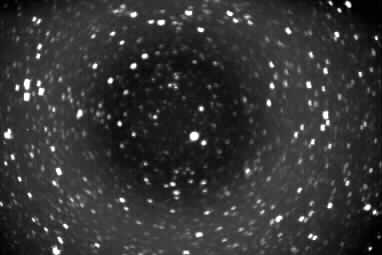
A theory gone wrong! This was what resulted after putting the 3.3 Focal Reducer back in front of the motofocuser. This image was taken just slightly up and left of Altair. It has a whopping 45" x 65" fled of view. The blackening in the middle shows what happens if you get the camer at the opposite extreme in distance from the Focal Reducer.
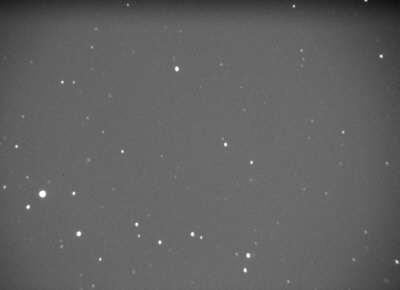
Starfield with asteroid 1969QR after image processing in CCDSoft

Finally a decent flat!
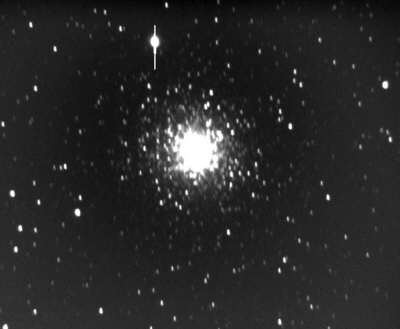
M15 with dark and flat processing.
So the answer in the end is to remove the motofocuser with the F3.3 Meade Focal Reducer since they really don't appear to be compatible. It appears that even though the Meade Motofocuser is not really what I wanted, I will be forced to buy theirs..
[Everstar] [Staff] [Gallery] [Astro Links] [ESO Info] [Tech Info] |
EverStaR. Copyright KC Resources

